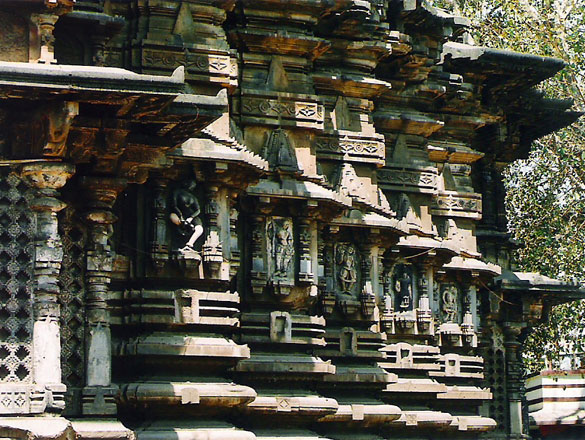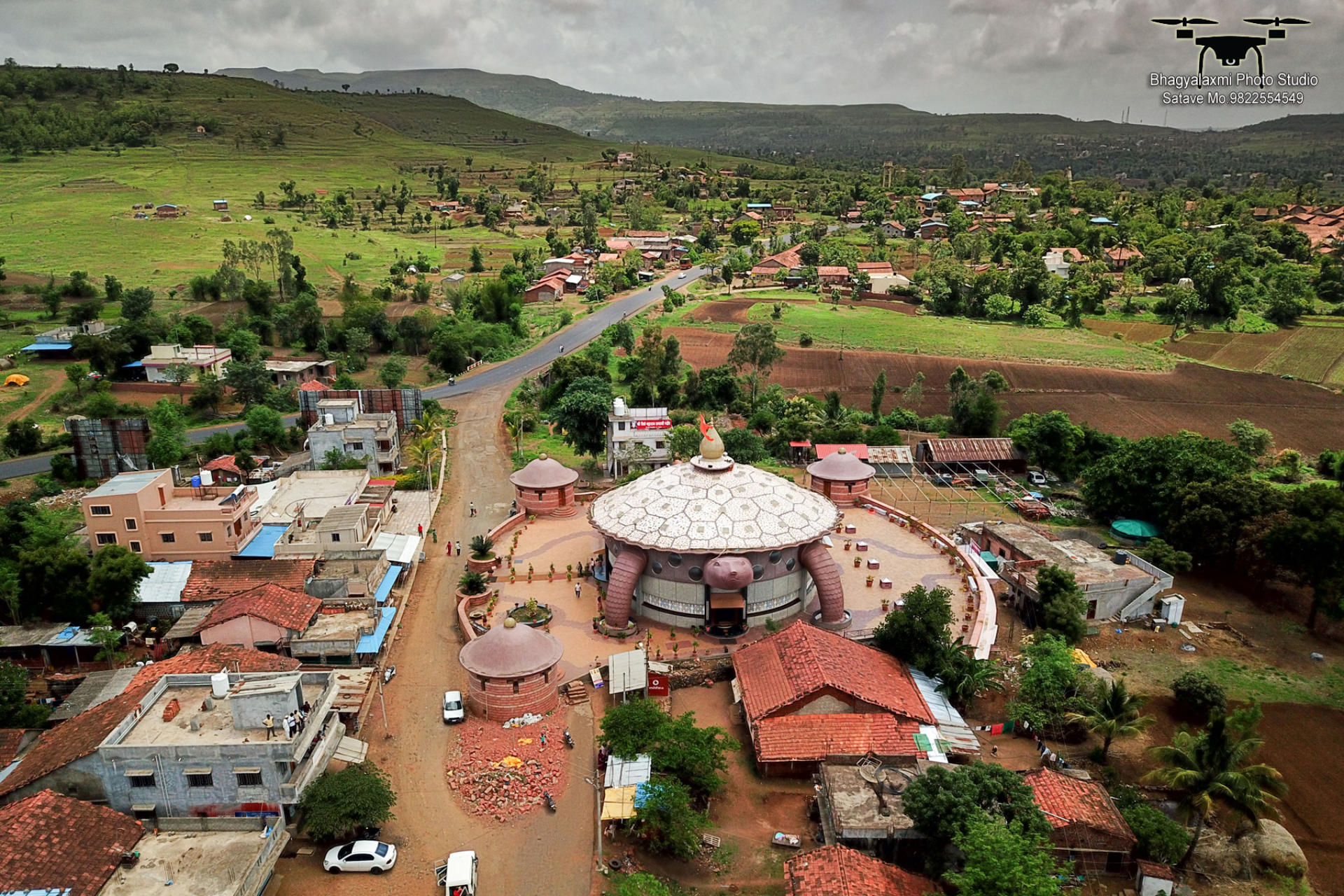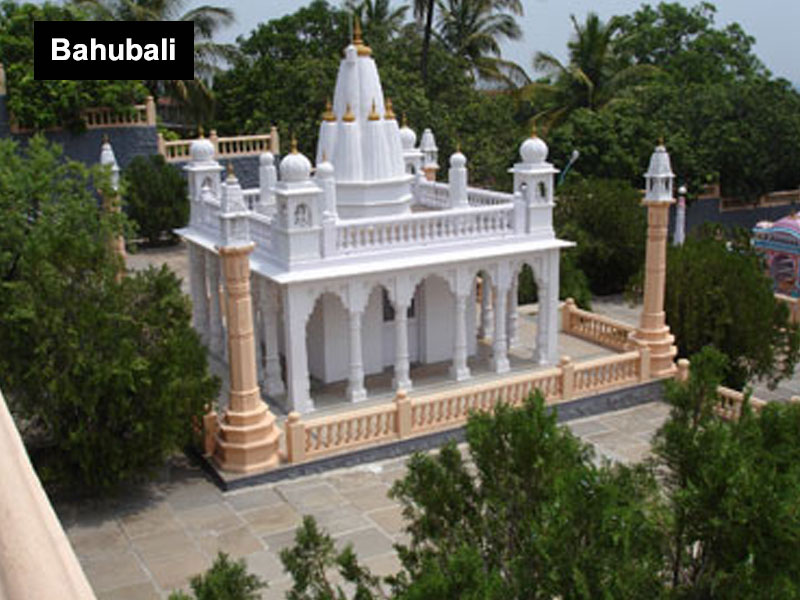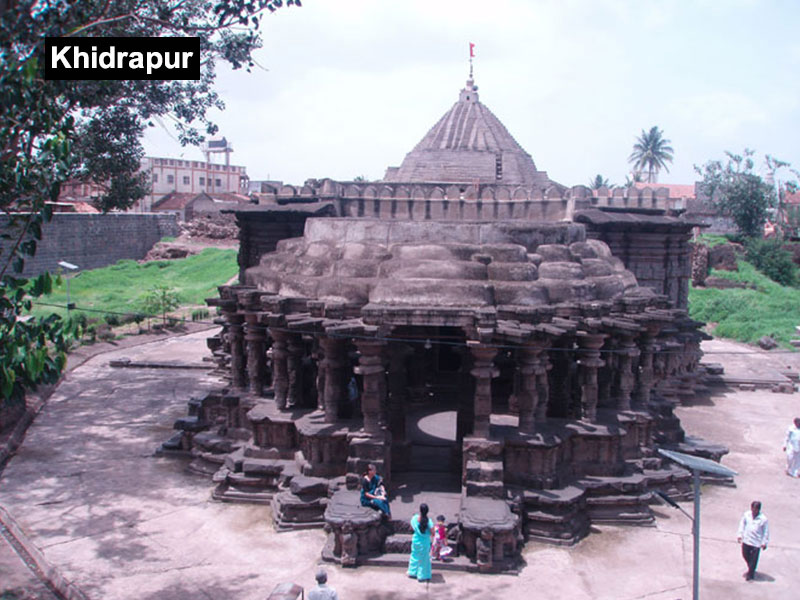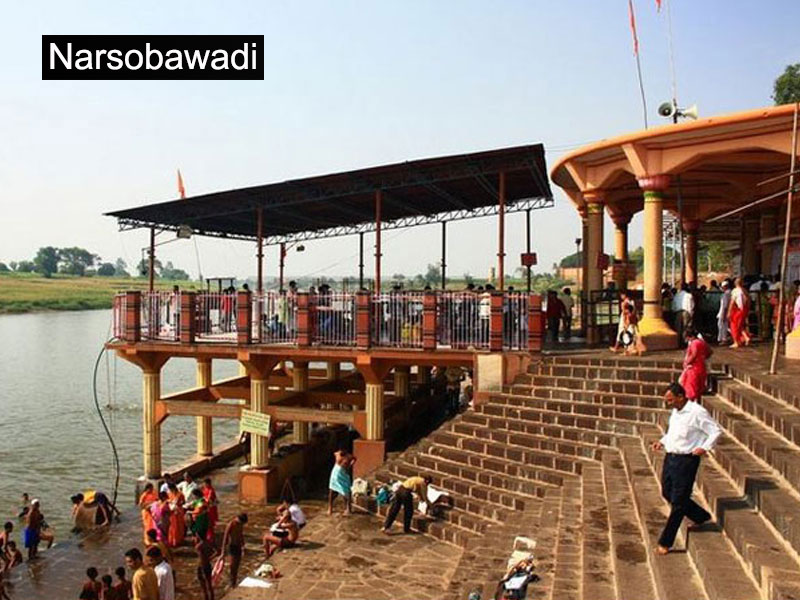Project Description
The Shri Mahalakshmi Temple of Kolhapur in Maharashtra, India, is one of the Shakti Peethas also called Dakshin Kashi, listed in various puranas of Hinduism. According to these writings, a shakti peetha is a place associated with Shakti, the goddess of power. The Kolhapur peetha is of special religious significance, being one of the six places where it is believed one can either obtain salvation from desires or have them fulfilled. The temple takes its name from Mahalakshmi, the consort of Vishnu, and it is believed that the divine couple reside in the area.
The temple belongs, architecturally, to the Kannada Chalukya empire, and may have been first built circa 700 AD. Mounted on a stone platform, the image of the four armed and crowned goddess is made of gemstone and weighs about 40 kilograms. The image of Mahalakshmi carved in black stone is 3 feet in height. The Shri yantra is carved on one of the walls in the temple. A stone lion, the vahana of the goddess, stands behind the statue.
The crown contains an image of the Sheshnag — the serpent of Vishnu. In Her four hands, the deity of Mahalakshmi holds objects of symbolic value. The lower right hand holds a mhalunga (a citrus fruit), in the upper right, a large mace (kaumodaki) with its head touching the ground, in the upper left a shield (khetaka), and in the lower left, a bowl (panpatra).
Unlike most Hindu sacred images, which face north or east, the image of this deity looks west (Pashchim). There is a small open window on the western wall, through which the light of the setting sun falls on the face of the image for three days around the 21st of each March and September.
Architecture of Mahalaxmi Temple, Kolhapur
The four Shakti Peethas of Maharashtra are Tuljapur enshrining Bhavani, Kolhapur enshrining Mahalakshmi, Mahur enshrining Mahamaya Renukaand Saptshringi enshrining Jagadamba. Other Shakti temples in the state are those at Ambe Jogai and Aundh.
Kolhapur is located in Kolhapur district and is well connected with Pune, 240 km north. It is on the national highway between Bangalore and Pune. It is situated on the banks of the Panchganga river and is full of ancient temples and shrines.
Legends: The Karavira Mahatmya states that Vishnu resides in the form of Mahalakshmi at Kolhapur. Legend has it that Kolhasura, a demon that tormented the Gods and other beings, was destroyed by Mahalakshmi here at Karavira, and that the spot of his death became a thirtha and that she took abode here in a shrine which constitutes the temple today. (Legend also has it that Parvati – Kolhambika destroyed the demon Kolhasura at Tryambakeshwar).
History: Although several parts of the temple are of the second half of the second millennium CE, epigraphic references place the deity in the 7th century CE, and the temple in the 10th century CE. For a period in the interim, this temple had fallen out of worship and the image of the Goddess was housed elsewhere. Worship was restored in the year 1715 after the Marathas rose to power.
The Temple: The main entrance Mahadwara of the temple is the western entrance. Upon entering the Mahadwara one is confronted with several deepamaalas on either side, and enters the Garuda mandap with square pillars and foliated arches of wood, characteristic of Maratha temples. This mandap dates back to the 18th century. An image of garuda faces the sanctum. Another stone mandap, on a raised platform enshrining Ganesh, also faces the sanctum. Following this is the mandap with three shrines facing west. The central one is that of Mahalakshmi and the two on either side are those of Mahakali and Mahasaraswathi.
The temple complex exhibits mortarless construction echoing the style of the early Deccan temples. Also to be noted here are the horizontal mouldings and the vertical offsets which create a rich light and shade pattern. Also seen in this temple is a rich display of sculpture of figurines in dancing poses, musicians, gods and goddesses. The three sancta have rather simple shikharas of brick and mortar dating back to the 19th century.
The image of Mahalakshmi carved in black stone is 3 feet in height. The Shri yantra is carved on one of the walls in the temple. The sanctum is designed such that once a year, the setting rays of the sun fall on the face of the image of Mahalakshmi for a period of 3 days in the months of Pisces and Leo.
Above the Mahalakshmi sanctum is a shrine with a Shivalingam and a nandi. The devakoshtas house Venkatesha, Katyayani and Gowri Shankar – facing the north, east and the south. There are a number of subsidiary shrines in the courtyard to the Navagrahas, Surya, Mahishasuramardini, Vitthal-Rakhmai, Shiva, Vishnu, Tulja Bhavani and others. Some of these images date back to the 11th century, while some are of recent origin. Also located in the courtyard is the temple tank Manikarnika Kund, on whose bank is a shrine to Visweshwar Mahadev.
Worship: Five worship services are offered each day here. The first one is at 5 am, and it involves the waking of the deity with a Kakada – torch, to the accompaniment of hymns. The second worship service at 8 am involves the offeirng of the Shodashopachara pooja consisting of 16 elements. The afternoon and evening services and the Shejaarati pooja constitute the three other services.
A festival image of the deity is taken out in procession around the temple courtyard each Friday, and on full moon days.
Daily Programme (Pooja)
| 4.00 a.m. | Opening of the Temple Entrance Gate. |
|---|---|
| 4.00 a.m. to 4.30 a.m | Ghantanaad (Ringing of the bell) |
| 4.45 a.m. | Opening of Main Door by the High Priest (Hakkadar Pujari) for that day. |
| 5.30 a.m. | Padhya Pooja (Washing the feet of the idol Goddess Mahalaxmi by Milk.) |
| 5.45 a.m. | Kakada Aarati of the Goddess Mahalaxmi. |
| 8.30 a.m. | Ghantanaad (Ringing of the bell) and Snan Abhishek (Bathing of the main idol. Goddess Mahalaxmi) |
| 9.30 a.m. | Aarati and Shankh Trith |
| 11.30 a.m. | Ghantanaad and Abhishek (Milk Bathing of the main idol. Goddess Mahalaxmi) |
| 12.30 to 1.00 p.m. | Aarati and Shankh Tirth |
| 1.30 to 2.30 p.m. | Alankar Pooja. Salankruti (i.e. Goddess is decorated with beautiful Gold ornaments, Sari and Blouse) This Pooja is kept upto 8.30 p.m. in the evening |
| 8.00 p.m. | Ghantanaad (Ringing of the bell) |
| 8.15 p.m. | Aarati |
| 8.30 p.m. to 9.00 p.m. | Mantrapushp and removing the Alankar (Gold ornaments.) and simple Pooja is performed |
| 10.00 p.m. | Ghantanaad (Ringing of the bell) |
| 10.15 p.m. | Shejarati (Last Aarti of the day.) |
| 10.30 p.m. | Temple’s Doors are closed. |
Other Important Rituals Performed
- Every Friday at 9.30 p.m.- Devichi Palakhi (i.e. procession of the idol Goddess Mahalaxmi in Palainquin.)
- On every Chaitra Pratipada – Procession of the idol Goddess Mahalaxmi is carried out in Chariot and Palainquin at 9.30 p.m. (Nagar Pradakshana)
- Procession of the Idol Goddess Mahalaxmi is carried out in Palainquin on every full Moon (Poornima) of Ashwin, Kartik, Margshirsh, Paush and Magh at 9.30 p.m.
- Palakhi (Procession) of the idol Goddess Mahalaxmi is carried out in Palainquin, daily during Navratri Ashwin pratipada upto Dasara Festival.
- Mahaprasad (Delicious Food) is distributed to thousands of Devoties after 12.00 p.m. on Ashwin Poornima. (full Moon)
- Abhishek and Kumkumarchan (Bathing the idol of Goddess Mahalaxmi with Milk and applying Kumkum on to the feets of the idol), are allowed to perform by male devoties only between 5.30 a.m. to 12.30 p.m.
KARTIK FESTIVAL
Starting from Narakchaturdashi to Kartik Poornima the Temple is opened in early morning at 2.00 a.m. and Kakada Aarati is performed.
KIRNOSTAV
i.e. the rays of the Sun fall on the Idol Goddess Mahalaxmi during Sunset.Kirnostav Dates :
Contact for Abhishekam

Prafulla Munishwar
We are the hereditary Pujaris of Shree Mahalaxmi Devi (Ambabai). We are officially and solely responsible for conducting pujas. aartis and opening and closing the temple doors. We help devotees who wish to make offerings to the Devi in the form of cash, ornaments, sarees etc. We also provide receipts for the various offerings made & send prasad to the devotees by post.
Prafulla Shridhar Munishwar
Shri Mahalaxmi Poojak
- Address :3068, A ward, Kapiltirth Market, Kolhapur.
- Tel. No.:0231 – 2623011
- Mobile.:+91 9823053802
- Website.: http://www.mahalaxmiabhishekamseva.com/
Time of Pooja :
नित्य कार्यक्रम ( पूजा विधी )
| पहाटेचे कार्यक्रम ( पूजा विधी ) | |
|---|---|
| पहाटे ४.०० वाजता | बाहेरील दरवाजा उघडणे. |
| पहाटे ४.०० वा ते ४.3० वा | घंटानाद |
| पहाटे ४.४५ वा | देवीचा मुख्य दरवाजा हक्कदार पुजारी उघडतात. |
| पहाटे ५.3० वा | देवीच्या चरणावर पुजारी दुध घालतात. ( पाध्यपुजा ) |
| ५.४५ वा. | देवीची काकडआरती |
| सकाळचे कार्यक्रम ( पूजा विधी ) | |
| सकाळी ८.3० वा. | घंटानाद आणि मुख्य देवीस स्नान व अभिषेक |
| सकाळी ९.3० वा | आरती आणि शंखतीर्थ |
| सकाळी ११.3० वा. | घंटानाद व मुख्य देवीस अभिषेक |
| दुपारचे कार्यक्रम ( पूजा विधी ) | |
| दुपारी १२.3० ते १.०० वा. | आरती आणि शंखतीर्थ |
| दुपारी १.3० ते 2.3० वा. | अलंकार पूजा ( सालंकृत ) – हि पूजा रात्री ८.३० वा. पर्यंत ठेवली जाते. |
| रात्रीचे कार्यक्रम ( पूजा विधी ) | |
| रात्री ८.०० वा. | घंटानाद |
| रात्री ८.१५ वा. | आरती |
| रात्री ८.3० वा. ते ९.०० वा. | मंत्र पुष्प व देवीचे अलंकार, पूजा उतरवतात व साधी पूजा बांधतात |
| रात्री १०.०० वा. | घंटानाद |
| रात्री १०.१५ वा. | शेजारती |
| रात्री १०.3० वा. | मंदिर बंद होते . |
इतर कार्यक्रम
- दर शुक्रवारी रात्री ९.३० वाजता देवीची पालखी निघते
- चैत्रप्रतिपदेला रथ व पालखी निघते – नगर प्रदक्षिणा
- अश्विन, कार्तिक, मार्गशीष, पौष, माघ या पौर्णिमेला रात्री ९.३० व पालखी निघते
- नवरात्र अश्विन प्रतिपदा ते दसरा पालखी नित्य असते.
- अश्विन पौर्णिमेला दुपारी १२.०० नंतर महाप्रसाद असतो
कार्तिक उत्सव
नरकचतुर्थी ते कार्तिक पौर्णिमा मंदिर पहाटे २.०० वाजता उघडते व काकडआरती होते .
किरणोत्सव
किरणोत्सव देवीच्या मूर्तीवर सूर्याची किरणे पडतात. किरणोत्सव दिवस :
अभिषेक करण्यासाठी संपर्क करा

प्रफुल्ल मुनीश्वर
आम्ही, श्री करवीर निवासिनी श्री महालक्ष्मी अंबाबाई देवीचे वंशपरंपरागत हक्कदार पुजारी आहोत व श्री महालक्ष्मी देवीच्या नित्य पूजा, आरती करणे, देवूळ उघडणे, बंद करणेचा आमचा हक्क आहे. श्री महालक्ष्मी देवीची महापूजा, कुंकुमार्चन देवी स्तुती मंत्र पाठासाहित सप्तशती पाठ व नवचंडी व नैवैद्य करणेकरिता कृपया आमच्याशी संपर्क साधावा.
भक्तांनी नवसासाठी दिलेली देणगी, अलंकार पूजेसाठी महावस्त्र, साडी त्यांचे समक्ष अर्पण केले जातील. त्याची पावती दिली जाईल. पोस्टाने पूजा प्रसाद पाठविला जाईल. कायम नित्य अभिषेक पूजा सेवा आमच्याकडे आहे. आपली सेवा श्री आदिशक्ती श्री महालक्ष्मी जगज्जननी जगदंबा चरणी रुजू आहे.
प्रफुल्ल श्रीधर मुनीश्वर
श्री महालक्ष्मी देवीचे हक्कदार पुजारी
- Address :3068, A ward, Kapiltirth Market, Kolhapur.
- Tel. No.:0231 – 2623011
- Mobile.:+91 9823053802
- Website.: http://www.mahalaxmiabhishekamseva.com/
पुजेची वेळ :




